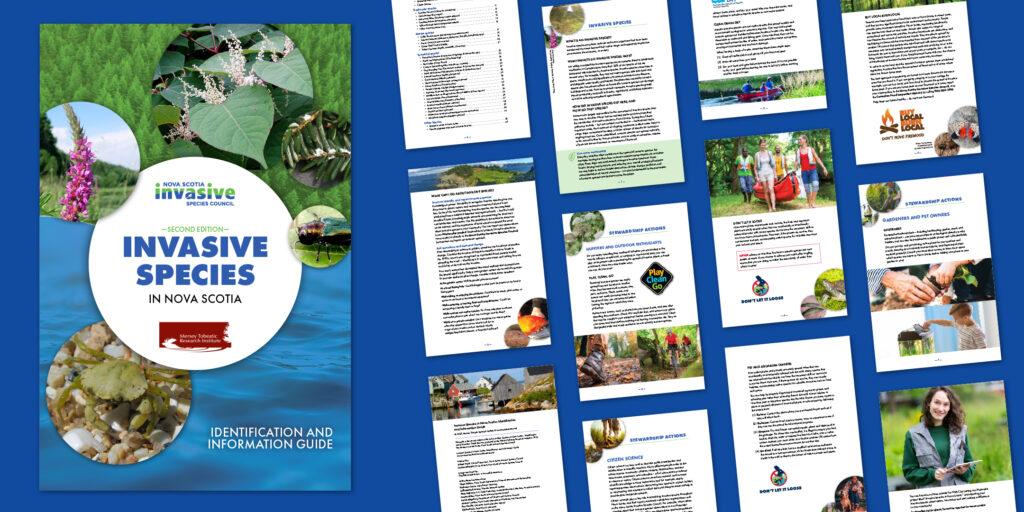
Yellow Floating Heart
VASCULAR PLANT Nymphoides peltata | Other Names: Fringed Water Lily, Water Fringe Description Yellow Floating Heart is a bottom-rooted, floating-leaved aquatic plant. Its leaves are round, heart or kidney-shaped, 3–15
Invasive species are plants, animals and micro-organisms that have been introduced into areas beyond their native range and negatively impact the environment, the economy, or society.
It is widely accepted that invasive species are an immense threat to biodiversity worldwide. In Canada alone, more than 20% of our species at risk are threatened with extinction by invasive species. Invasive species cause harm in several ways. For example, they may eat native species, take their food and space, contribute to soil degradation and erosion, introduce new diseases, and degrade water quality and habitat. The destruction caused by invasive species also has adverse effects on human life. Invasive species can damage buildings and roads. From an economic viewpoint, invasive species greatly impact productivity and profit in forestry, agricultural, and fishing industries – as well as reducing recreational opportunities.
Humans are largely responsible for the movement of invasive species from one area to another. Many human-assisted pathways have permitted the introduction of invasive species in Nova Scotia. Examples of these pathways include – but are certainly not limited to – horticultural trade, aquarium trade, the movement of shipping containers, ballast water tanks in cargo ships, recreational boating, and the release of species for hunting or angling purposes. Once established, invasive species can spread naturally, or be moved further by human activities such as outdoor recreation, release of pets into the environment, or movement of firewood.
Everyday activities often contribute to the spread of invasive species. For example, buying products from overseas requires transportation via container ships; those ships may inadvertently transport invasive species to Nova Scotia. Buying local products and reducing your overall ecological footprint not only helps to reduce habitat destruction, climate change, pollution, and overexploitation of natural resources – it is also fundamental for the prevention of invasive species introductions across the globe.


VASCULAR PLANT Nymphoides peltata | Other Names: Fringed Water Lily, Water Fringe Description Yellow Floating Heart is a bottom-rooted, floating-leaved aquatic plant. Its leaves are round, heart or kidney-shaped, 3–15

VASCULAR PLANT Iris pseudacorus | Other Names: Yellow Flag Iris Description This perennial wetland plant has three drooping petal flowers that are bright yellow, but sometimes have brown spots or

WATCH LIST Dreissena polymorpha ABOUT IMPACTS PREVENTION All Hands on Deck! Zebra Mussels are an urgent threat to local water bodies because they: Disrupt ecosystems and native species. Damage infrastructure
VASCULAR PLANT Rubus bifrons Description Himalayan Blackberry is a very large blackberry that produces robust arching 5-angled canes that reach up to 3 m in height and 12 m in […]
VASCULAR PLANT Berberis thunbergii | Red Barberry, Thunberg’s Barberry Description Japanese Barberry is a deciduous, woody shrub in the barberry family (Berberidaceae). It has small, oval, spoon-shaped leaves with smooth […]
VASCULAR PLANT Reynoutria japonica | Other Names: Mexican Bamboo, Fleeceflower Description Japanese Knotweed is a woody-stemmed herbaceous perennial 1-3 m tall, with annual stems extending from the perennial root system. […]
VASCULAR PLANT Rosa multiflora | Common names: Multiflower Rose, Rambler Rose Description Multiflora Rose is a woody shrub that grows up to 3 m tall and 4 m wide. Its […]
VASCULAR PLANT Acer platanoides Description Norway Maple is a large deciduous tree that grows up to 18 m tall with a large crown. It has large, maple-shaped leaves, which can […]
VASCULAR PLANT Celastrus orbiculatus | Asian Bittersweet Description Deciduous woody vine or trailing shrub. Can reach heights of over 18 m. Leaves simple, alternate, roundish and slightly toothed. Flowers small […]
MARINE MACROALGAE Codium fragile | Codium, Dead Man’s Fingers Description Green alga shaped like a small bush, velvety and spongy to the touch. Light to dark green. Branches are thick […]
VASCULAR PLANT Lythrum salicaria | Other Names: Loosestrife, Spiked Loosestrife Description Stems arise from perennial rootstock. 30-50 stalks can arise from a single rootstock, but the average is between 1-15. […]
REPTILE Trachemys scripta elegans Description Red-eared Sliders have brown to olive green coloured shells, with a slight keel running down the center. Green-black stripes run along the body. Sliders are […]